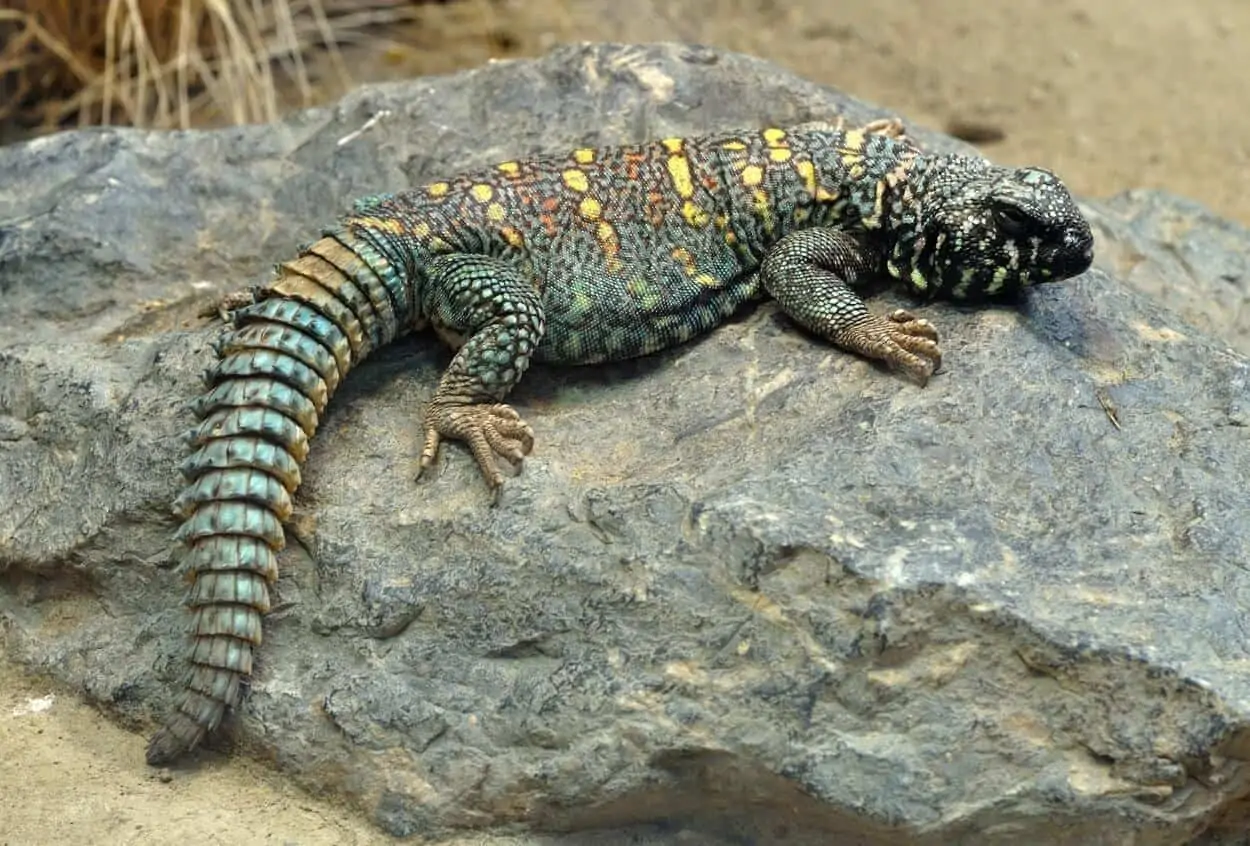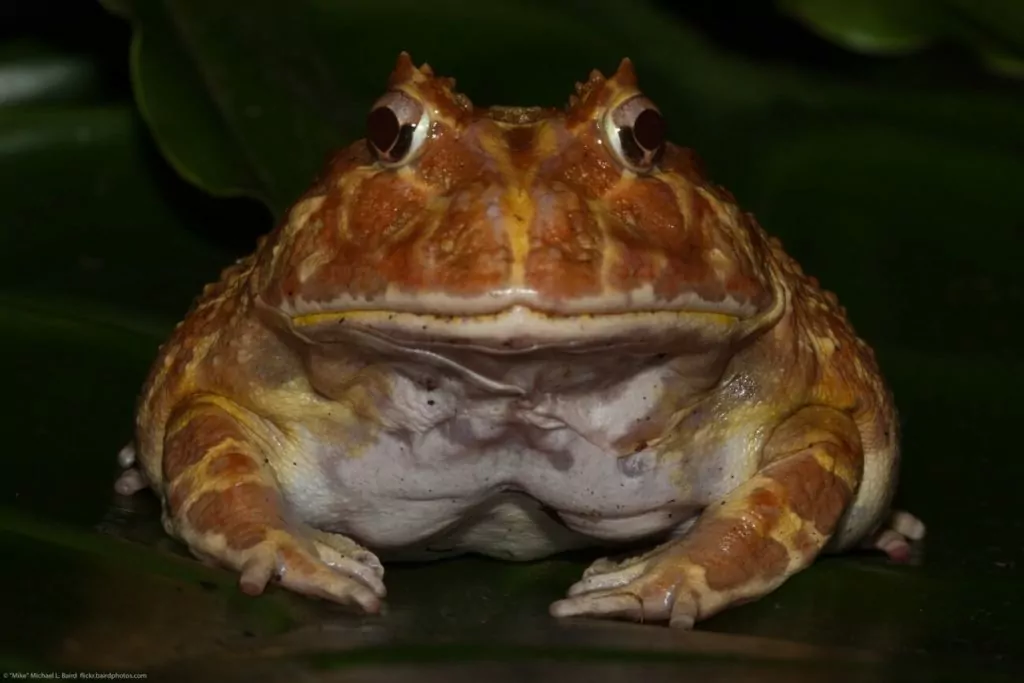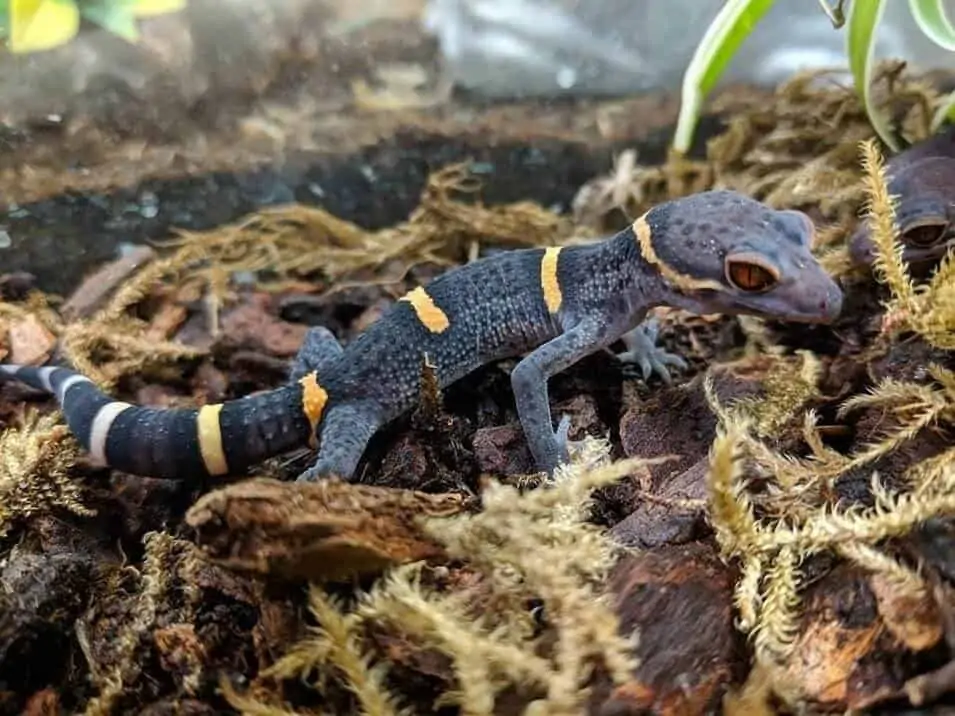Uromastyx (aka spiny-tailed lizards) are a fantastic pet reptile that has skyrocketed in popularity over the last few years. They’re fairly easy to care for, look beautiful, and are fun to handle as well.
But these lizards are one of the most misunderstood species out there when it comes to care guidelines. Due to the fairly recent interest, there’s a lot of conflicting information being passed around about their requirements.
So we made this guide to set the record straight.
In it, you’ll learn everything you need to know about uromastyx care. We cover things like diet, enclosure size, habitat setup, lifespan, and much more!
Table of Contents
Species Summary
Sometimes referred to as the spiny-tailed lizard, the uromastyx is a unique reptile that not too many enthusiasts know about.
While these lizards have been a part of the trade for a while now, breeders have only recently started seeing progress. As a result, captive populations are growing slowly.
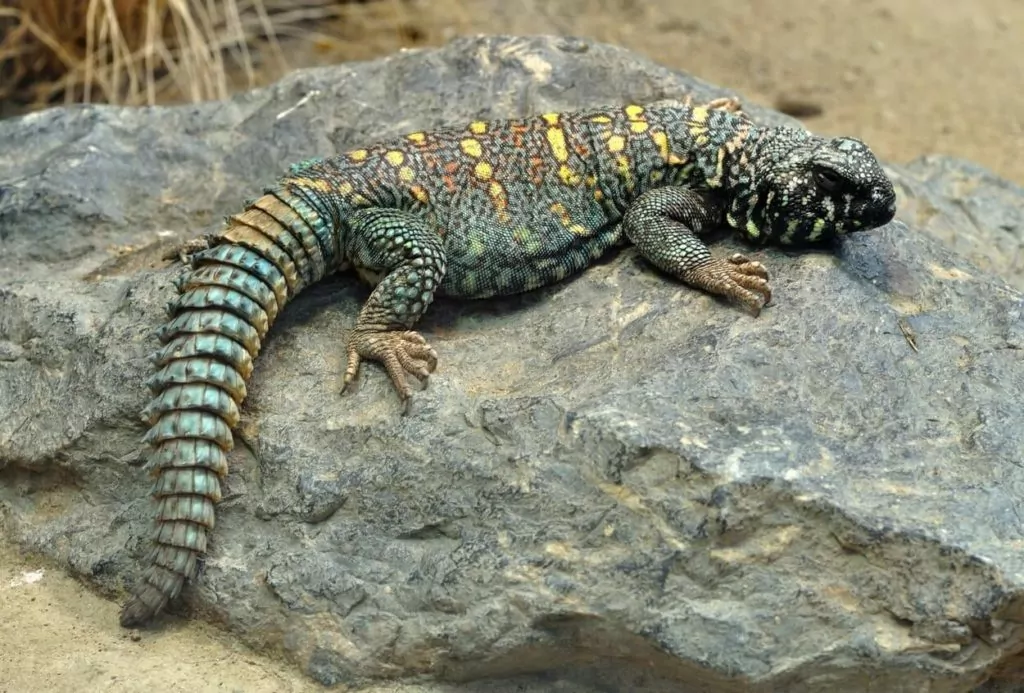
The uromastyx comes from Northern Africa and part of the Middle East. They’re desert-dwelling creatures that prefer dry and arid climates. Most often, the lizards stick to places with rocky outcroppings that they can hide in.
There are about 14 different uromastyx species. They vary wildly when it comes to size and coloration. However, their care requirements are very similar.
In captivity, the uromastyx requires a similar environment to stay healthy. Most consider the reptile to be moderately difficult to care for. Thus, they’re best for hobbyists with some previous experience in the needs of pet lizards.
Lifespan
The average uromastyx lifespan is between 10 and 20 years when healthy. The life expectancy of these lizards depends entirely on the quality of care you provide.
Owners who put in the work to cover all of the basic needs can expect their reptile companion to live much longer than those who cut corners! Poor husbandry can lead to stress, disease, and untimely death for these lizards.
Appearance & Colors
The most identifying feature of the uromastyx is the tail. Each one is equipped with a large spiny tail that takes up about a third of its body!
Expert Tip: This applies to all uromastyx lizards regardless of the specific species.
The thick points act as a defense mechanism for the reptile. Though, the spikes do not cause harm when touched.
The rest of the body is flat. You might see some more subtle spines running along the back and legs.
Unlike many tree-dwelling lizards, the legs of the uromastyx are quite beefy. They’re terrestrial creatures, so they use their legs to scurry across the dirt. The muscular shape of the legs reflects that. As for the feet, they feature short toes complete with claws for digging.
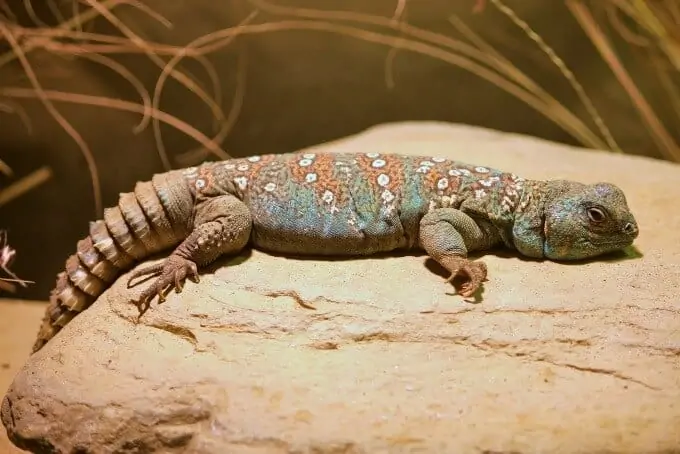
The color of the uromastyx depends on the species. Many species also have different colors between males and females.
Take the uromastyx ornatus for example (this is one of the more popular species). The males typically have a base color of dark blue or green. On top of that, the body is adorned with pops of bright yellow and orange!
Meanwhile, females are duller in appearance. They have shades of tan and brown. Muted tones of yellow and orange are common as well.
Average Size
The average size of a uromastyx is anywhere between 10 to 30 inches in length. The reason for this large range is because their size varies significantly depending on the species you get!
Expert Tip: The smallest known uromastyx is the uromastyx hardwicki. It can reach lengths of 10 inches when fully grown. The largest is the Egyptian uromastyx, which can exceed 30 inches as an adult.
Uromastyx Care
Proper uromastyx care requires a slightly different approach than many popular tropical lizards in the reptile trade. However, their low-maintenance nature makes them very beginner-friendly.
Unfortunately, there’s a lot of misinformation floating around out there. This is partly because many owners had to figure things out on their own during the lizard’s less popular years as a pet.
Thankfully, we now how some established care guidelines to follow. Here are some things you need to know to keep your uromastyx happy and healthy.
Enclosure & Tank Size
The most important thing to consider is where you’re going to keep your uromastyx (and how large the enclosure should be). You have several options.
Smaller uromastyx and juveniles can do just fine in standard reptile terrariums of 20 gallons or more. You can even use plastic containers.
However, bigger adults will need a lot of space to grow.
We recommend getting an enclosure that measures at least 5 feet long, 2 feet wide, and 2 feet tall. A standard reptile enclosure with sliding front doors is good.
Expert Tip: The length of the enclosure is the most important factor here. These are terrestrial creatures that need room to roam. Plus, a longer habitat makes things easier to create a temperature gradient.
Make sure that your enclosure has ample ventilation. Humidity control is key with uromastyx, so you’ll need a way to make adjustments as needed.
If you live in a hot and dry climate, you may be able to keep your uromastyx outside. Many owners have seen success in creating larger environments for groups of lizards to call home. However, this is best reserved for owners with a fair bit of experience.
Habitat Setup
Let’s start with the substrate. The best type of substrate is going to be one that doesn’t hold onto moisture or raise humidity levels.
We recommend using a mixture of sterilized play sand and soil/peat. The substrate resembles their natural environment and won’t retain moisture like wood chips or moss. Avoid anything like alfalfa, mulch, or coconut fiber. Not only will it ruin humidity levels, but the material can cause impaction if ingested.
If you want something easier to clean, you can even use bare floors or tile. As long as it’s non-porous, it will work well. However, smooth surfaces might not be the most comfortable for the lizard and we generally recommend avoiding them if you can.
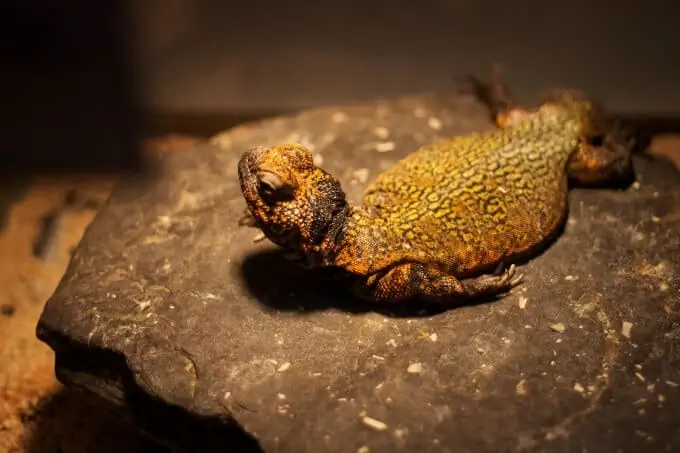
Once you add a thin layer of the substrate into the enclosure, you’re going to need two more decorations. These are a hide box and a basking rock.
The hide box is going to be a place of shelter for the lizard. It will also have naturally higher humidity levels, making it easy for the uromastyx to get comfortable.
Use a large container that can fit the lizard comfortably. You can use a wooden box, an artificial cave, or even an old food container. Place the box on the cool end of the enclosure.
For the basking rock, you can use something like slate. Slate holds onto heat even after the lights are off, which is beneficial for the lizard. Place the rock near the hot end of the enclosure where the basking light will be.
Temperature & Lighting
As you might have guessed from the previous section, creating a temperature gradient in the enclosure is crucial. The uromastyx will self-regulate its body temperature by moving from one end of the environment to the other.
Use a basking light to raise the temperature of one end of the tank.
Expert Tip: Uromastyx lizards like temperatures as high as 120 degrees Fahrenheit in the basking spot! For the cool side, temperatures should be in the 80s.
These lizards can tolerate temperatures as low as the upper 60s at night. If ambient temperatures get lower than that, consider using a heat emitter of under-tank heating system.
Your lights should be on during the day and turned off at night. Uromastyx are diurnal, so they need a standard day and night cycle.
In addition to the basking light, you’ll need a UVB lamp. The UVB lamp simulates sunlight and helps the lizard’s body metabolize calcium. The light should cover the entire enclosure for 10 to 14 hours every day.
Humidity
Unlike some other popular lizards you might be familiar with, uromastyx do not tolerate high humidity levels!
These reptiles need humidity levels to be below 35 percent at all times. Use a reliable hygrometer to check the levels regularly. If they get too high, improve air circulation throughout the enclosure by opening vents.
Also, avoid misting or excess moisture. If you notice any major spills in the environment, pick them up as soon as possible to avoid evaporation and increased humidity.
Water
The uromastyx will get most of its hydration from the food it eats. However, having a small water dish is still important.
Provide a shallow water dish filled with filtered and dechlorinated water. Make sure to keep an eye on the water quality and replenish the dish regularly.
Uromastyx Diet
The ideal uromastyx diet has been a point of contention for reptile owners for many years! Let’s finally put this issue to rest!
Uromastyx lizards are omnivores. However, they do best on plant-based foods rather than meat-based foods. There is evidence that a high-protein diet can actually lead to a host of health problems.
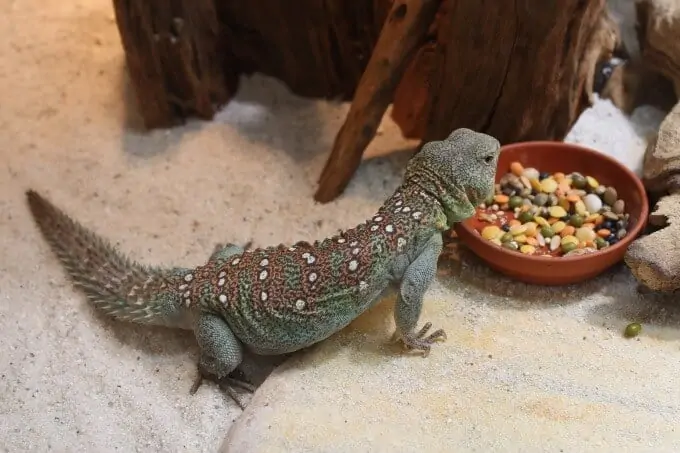
These lizards can handle occasional crickets and mealworms. But those treats should be few and far between.
The best food for these lizards is going to be a mix of leafy greens, beans, and vegetables. You can make salads with different ingredients to meet their dietary needs.
Here are some foods you can try out:
- Romaine lettuce
- Carrots
- Split peas
- Sweet potatoes
- Crushed beans
- Corn
- Peas
- Arugula
- Squash
- Kale
- Lentils
- Aflfalfa
- White millet (birdseeds)
You can feed both juvenile and adult uromastyx daily. Just keep an eye on their weight and adjust portions accordingly.
For good measure, you can sprinkle in some calcium powder or multivitamin supplements every third or fourth meal.
Expert Tip: To ensure that your lizard is only eating the food you provide, place the feeding dish on a rock or raised platform. This takes it off the substrate and ensures that the lizard doesn’t eat anything that could cause impaction.
Potential Health Issues
Some common health issues that affect uromastyx are metabolic bone disease, tail rot, and respiratory infections.
Metabolic bone disease is a result of not getting access to sunlight or UVB light. Without UVB rays, the lizard isn’t able to properly metabolize calcium. As a result, the bones become brittle and deformed.
Lizards that suffer from this disease are prone to injuries and often experience significantly shorter lifespans. To avoid the disease, make sure that you’re using a UVB lamp and replacing the bulbs every six months or so.
Both tail rot and respiratory infections are a product of too much humidity. Tail rot is caused by an infection that slowly eats away at the tail. For respiratory infections, bacteria cause inflammation in the throat, eye, and nasal tissue.
This means it’s always important to keep an eye on the humidity! Do everything that you can to keep the humidity level under 35 percent.
Behavior & Temperament
Uromastyx lizards are rather smart and can become very comfortable in the right environment. However, it does takes time to get to that point.
Oftentimes, these lizards will appear skittish as they’re getting used to their surroundings. During this time, they will spend the day in hiding. Slowly, they’ll get more comfortable and start spending time exhibiting more normal behaviors.
Throughout the day, your lizard will be moderately active. You might find them lounging on the basking rock whenever they need heat. Or, you may see them digging in the substrate or relaxing in the hide box to cool down.
Spiny-tailed lizards can get a bit territorial. This is especially true with males. If kept together, males will constantly fight, which could lead to injuries.
On the other hand, females tend to do well together. You can also raise males and females together for a bonded pair.
Handling Them
As with any reptile, you must build trust with the uromastyx before you start handling them regularly. To do this, you can pick them up for short periods or hand-feed them (their licking can tickle by the way).
The more interaction you have with the reptile, the quicker they’ll start trusting you.
Once you get to that point, the uromastyx doesn’t mind being handled. They’re docile and have no problem remaining calm as you hold them!
Conclusion
Uromastyx care doesn’t have to be complicated. In fact, once you’re familiar with some of the unique aspects of this lizard everything gets a lot easier!
We hope this care sheet gives you the confidence to go out and purchase one for yourself. These reptiles are incredibly rewarding to own and we recommend them to pretty much anyone.
If there’s anything we didn’t cover in this guide that you’d like some help with, feel free to send us a message through our contact page. We always enjoy helping our readers directly!

